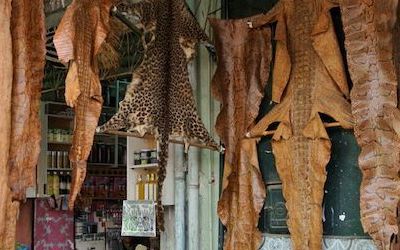Medicinal Trade of Reptiles in Morocco
By: Daniel Bergin & Vincent Nijman, Researchers, Oxford Wildlife Trade Research Group, Oxford Brookes University
In many of the thousands of shops that line the streets of Morocco’s medinas, buyers can find anything from traditional Berber carpets to smartphones. One type of shop, “herbalists” specialise in herbs, spices, oils and traditional medicines. Reptiles and their parts are often found in these shops, a practice persisting from Morocco’s historic past. Accounts of the traditional medicines of Morocco date back as far as 1810 – James Grey Jackson described, in colourful language, the practice of burning chameleons:
“Various medicinal qualities are assigned to the flesh of the chameleon; and many whimsical effects are attributed to fumigation with it when dried. Debilitated persons have recourses to it, and it is accordingly sold in all the drug shops at Morocco [present day Marrakesh], Fas [Fez], and other places. The smell arising from the fumigation is by no means grateful; but what scent will prevent an African from using that remedy which credulity or superstition has persuaded him will give strength to the impotent!”
Despite this, and other more recent accounts, no previous studies have quantified the number of animals used in Morocco for medicinal purposes. To investigate trade of reptiles for medicinal practices, our study carried out 49 surveys of 20 towns and cities in Morocco, as well as the two Spanish cities of Ceuta and Melilla – the only European cities located on the African mainland. We noted the presence of any wild species found in markets and, where possible, gathered information on their uses, turnover and origins.
We recorded more than 1,500 specimens of at least 9 reptile species in 14 cities and towns. Marrakech and Casablanca contained the most specimens with an average of 163 and 86 per survey in each city, respectively. The specimens observed, together represent in the region of USD 100,000 worth of goods. The most commonly observed animals were Mediterranean chameleons and Bell’s dabb lizards, sold both live and taxidermal. Traditional applications of wildlife in Morocco combine cultural, mystic and medical uses. The uses of animals were reported as varied, but reflect the traditional uses of the past. Chameleons were mostly sold dried and perceived to protect from a range of ailments, from headaches to the evil eye (a look from a person that is supposed to invoke a curse or bad luck). Stuffed bell’s dabb lizards are placed under the corner of a new house to bring luck or can be burned to help with eye irritation.
Morocco has recently brought in national legislation to protect wildlife from overexploitation, with fines of up to USD 10,000 for trade of any species within the highest category of protection (e.g. species included on CITES Appendix I) according to Law n°29-05 on the Protection of Species of Flora and Fauna and the Control of their Trade. Despite these new laws the trade has not diminished over time, nor has the openness of the trade. Reptiles are still sold openly and throughout the country. With this information, we intend to lobby the government to better enforce national wildlife trade laws in hopes that Moroccan authorities will use these new laws to curb the unregulated trade of reptiles in markets. We are also planning to expand our research to Algeria and Tunisia, building a more thorough regional ethnopharmelogical study on the uses of reptiles and other species in medicine.
More information can be found here
Article edited by: Nafeesa Esmail






